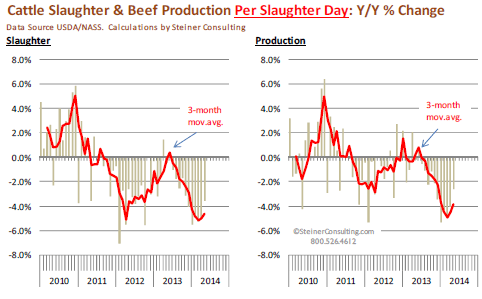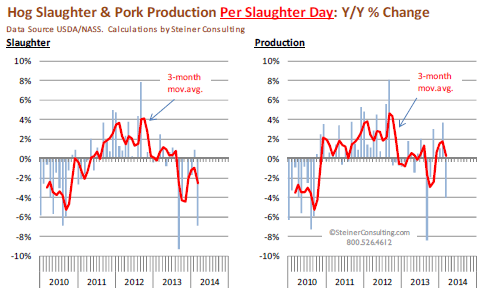



CME: Dramatic Shifts in US Livestock Market
US - The latest USDA monthly production statistics continued to highlight the dramatic shifts that have taken place in the US livestock market this year, write Steve Meyer and Len Steiner.The situation has been particularly acute in the cattle market, with cattle numbers down sharply compared to year ago levels and dramatically lower than where they were just a few years ago. The shortfall in livestock numbers (especially in the case of cattle) helps explain some (not all) of the price inflation so far this year.
We think the charts below give a good illustration not just of what has happened this year, which is a significant supply contraction. Rather, they show that meat production in the US has been constrained for a number of years. The initial response from market participants was to find ways to minimize/hide the impact of smaller supplies and higher prices. This was likely done through changes in portion size, changes to the product mix to include less expensive products and also likely smaller margins for all along the supply chain.
At some point end users run out of maneuvering room and significantly higher prices are required to reflect the changes in supply conditions. Add to this the improvement in consumer balance sheets, which tend to have a wealth effect on overall meat consumption. Below are some of the key statistics from the latest USDA production number for May:
Total cattle slaughter for May at 2.635 million head was 8.0 per cent lower than a year ago. But there was one less slaughter day in May 2014, which skewed the numbers. One way to adjust for this is to calculate the average slaughter per slaughter day. On this basis, daily cattle slaughter in May averaged about 125,476 head, 3.6 per cent less than the same period a year ago. The following chart shows an interesting fact. We saw a similar drop in slaughter during late 2011 and early 2012.

However, the impact on production was not as significant as heavier weights offset the decline in slaughter. This year, however, weight gains have been quite small and total beef production in May at 2.071 billion pounds was down 7 per cent. Average daily steer slaughter in May was down just 1.9 per cent from a year ago and when adjusted on a daily basis, it actually increased by 2.8 per cent. This 2.8 per cent increase follows a 1.5 per cent increase (average daily slaughter) in April.
With more steers coming to market than a year ago, it is clear that the primary reason for the decline in cattle slaughter is the sharp drop in the number of heifers and cows coming to market. It’s safe to say that herd rebuilding impetus is real strong, with weather at this point the major wild card that could slow it down. Heifer slaughter in May was down 10.5 per cent from a year ago.
On an average daily basis, heifer slaughter was down 6.3 per cent from a year ago. Heifer slaughter has totaled 3.486 million head in the first five months of the year, down 302,000 head (-8 per cent) compared to the Jan - May period in 2013. Cow slaughter during this period was 2.341 million head, down 338,700 head (- 12.6 per cent) compared to last year.
Producers throughout the country are trying to hold on to the female stock as profits in the cow-calf sector have skyrocketed. And the impact of the shortfall can be seen in the cattle markets, with fed cattle prices near $150 in late June and feeders trading north of $200/cwt.
Commercial hog slaughter in May was 8.619 million head, down 6.4 per cent from a year ago. When adjusted for the extra marketing day, however, average daily hog slaughter was down 2 per cent compared to a year ago. Still, hog numbers have been tracking consistently lower than a year ago in recent months.
Total hog slaughter for the period Mar—May was 26.148 million head, down 1.736 million head (-6.2 per cent) compared to the previous year. Keep in mind that this period corresponds to the Oct - Dec pig crop, a time when PEDv was not at its worst yet.
Producers have been able to offset much of the reduction in slaughter by bringing hogs to market at heavier weights and total pork production in May was 1.859 billion pounds, 2.1 per cent lower than last year. Average daily pork production at 88.54 million pounds was actually up 2.6 per cent in May.







